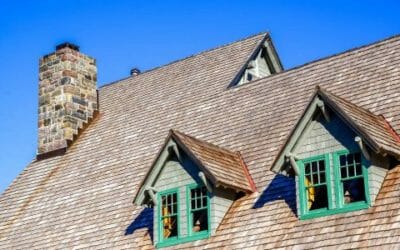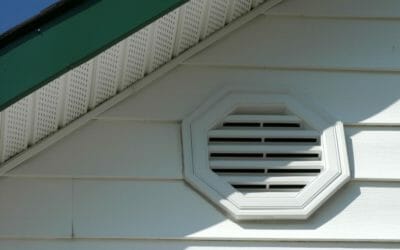A high profile hip and ridge shingle is designed to enhance the architectural shake-like appearance and dimensional profile of a premium architectural fiberglass shingle roof. The overall benefit is an enhanced curb appeal, increased durability, and most manufactures offer a higher wind warranty.
This is relevant for convex corners where two roof slopes come together – meaning the ridges and hips (lateral pitch changes are treated differently, as on a mansard roof). Traditionally, either dissected 3-tab shingles or manufactured standard-profile ridge and hip shingles are used for hips and ridges. Manufactured hip and ridge shingles are also known as “ridge caps,” whether they are standard profile or high-profile.
“High profile” hip and ridge is a product manufactured specifically for this purpose. Bought in bundles, shingle manufactures make high profile hip & ridge caps color-matched and compatible with the main shingles used on the roof.
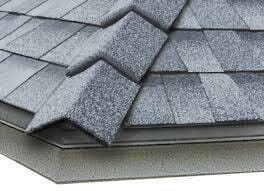
Here are the main benefits of High-Profile Hip and Ridge. We will go into more detail below as well:
- Aesthetic: High-profile design accentuates the roofline and adds dimension, depth and texture
- Durability: Multi-layer construction for durability and superior tear strength, plus no degrading along bend-line
- Wind-rating: Self-sealing adhesive backing for easy installation and maximum wind protection
- Easier Installation: Larger size, fewer pieces to install, and premanufactured profile means less labor needed for install
The high-profile hip and ridge shingle is a great addition during a re-roofing project. This would be an upgrade from a traditional hip and ridge shingle, so there will be a higher cost. As always, consult with a reputable roofing contractor in your area to get more details and pricing.
Why Are High Profile Hip and Ridge Shingles Better Than Regular Shingles?
Added Superior Wind Uplift Resistance
Kansas is famous for our wind, so this is a big deal for us here. Wind uplift is responsible for fiberglass shingle damage, with movement and bending in the shingle creating cracks in the layers and eventually allowing water through. For detail on the layer and material construction of composite asphalt shingles, learn more here.
High profile hip and ridge shingles are thicker and heavier than standard ridge and hip shingles, adding depth and weight for superior wind resistance. This could save money down the line through increased lifespan and avoiding repairs.
Added Durability and Impact Resistance
Dedicated hip and ridge cap shingles are manufactured with a bend, meaning that the layers do not risk cracks or exposure from surface granules being more spread out when flat shingles are bent to make hip/ridge caps. The steeper the slopes falling away from the ridge, the more relevant this is to have ridge caps that are manufactured with a bend (plus the steeper the roof, the more visible the hips and ridges are from below for aesthetic considerations).
Unsurprisingly, ridges are typically the most susceptible to damage from hail, as there is no advantage of glancing blows. However, we often see during inspections that this is exacerbated by granule loss along the bend of cut 3-tab shingle ridge caps, which further exposes the shingle mat over time.
Best of all, high profile hip and ridge shingles are built from multiple layers, providing the durability and impact resistance desperately needed here in the Midwest, where hail is prevalent.
Ease and Speed of Installation
High profile hip and ridge shingles do not need to be cut on-site, making them easier to install than standard hip and ridge shingles. Additionally, many higher-end cap shingles are fully self-adhesive. Adhered shingles eliminate mechanical fasteners, which are the culprit of the most common roof leaks. High profile hip and ridge shingles use fewer components than standard hip and ridge shingles, making them more efficient to install.
Improved Curb Appeal with Striking Visual Lines
Adding striking visual lines to each hip and ridge enhance the straight lines that make up the contour of the building, adding a sophisticated elegance while increasing curb appeal. Some homeowner’s association communities even require high profile hip and ridge on all properties to elevate the overall look of the neighborhood.
HIGH PROFILE CAP
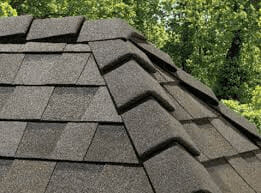
VS
NORMAL RIDGE CAP
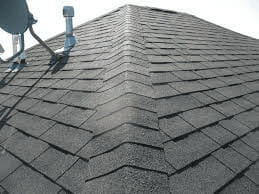
How Much More Does High Profile Hip and Ridge Cost?
Adding high-profile hip and ridge caps will likely add between $150 and $700 on a residential roof replacement, or roughly a 1-2% increase in the total price of the roofing job. The shingles themselves are more expensive, but installation labor is comparable (or even a little less), so this feels like the most reasonable way to compare end costs to customers. We looked at our historic job costs and comparing how much adding high profile hip/ridge cap changes the total cost of complete roof replacement. With a bundle of ridge cap covering 33 linear feet, the median cost-to-upgrade of all the homes we evaluated was $215.
Of course, the biggest variable is how many feet of hip and ridge your building has. A simple gable roof, which only has one ridge at the top, won’t change the price much, whereas a complex hip roof with dormers has a lot more linear feet to cover. The truth is, hips and ridge make up a small percentage of a total roof system, which keeps the proportionate cost of an upgrade low.
Rhoden Roofing completes over 500 roof replacements each year, so we feel this estimate on costs is an accurate representation across a variety of roofs. We reflect the cost difference simply a reflection of the more expensive materials/shingle price. However, it is worth mentioning that different contractors may treat pricing differently, especially because high profile hip and ridge is considered a premium product. As low-profile caps are considered the default option, many roofing contractors rarely (or never) install high profile ridge caps, and may have to special order the material, charge additional markup for a premium product, or charge higher labor costs if their team is not used to installing the product.
For a lot more detail and breakdown of roofing costs to expect for replacements, repairs, and components, see our Cost Series.
The shingles themselves (raw material) vary by manufacturer, but cost roughly 25% more than manufactured standard (low-profile) cap shingles, or about 80% more than cutting 3-tab flat shingles into hip/ridge caps. Many shingle manufacturers do not offer color-matched or compatible 3-tab shingles to match their lines of architectural shingles, so the latter option may not be possible.
While technically possible, we’ve never had a customer change to a high profile outside of an existing roof replacement – the labor cost to carefully remove and replace each individual shingle without damaging neighboring ones would be cost-prohibitive. On new construction or on a roof that is already being replaced anyway, the labor is the same (even slightly less) to install high-profile, so that is the time when people make the change.
Are High Profile Hip and Ridge Shingles Compatible with Any Roof?
You can add high profile hip and ridge shingles to any pitched shingle roof (what are the varieties), but they are almost always installed with architectural shingles or premium shake-like asphalt shingles. Architectural shingles, also called dimensional shingles, are thick and typically have a deep texture. The aesthetic is more reminiscent of classic wood roofs, which is where the look of high-profile hip and ridge originated.
Why Are Hips and Ridges Important on a Roof?
In high wind situations (as is often the case here in Wichita), steep pitch roofs divert the wind upwards. Known as wind uplift, this force can lift any shingle, but hip and ridges shingles are particularly at risk.
Hip and ridge shingles don’t lie flat on the underlayment like a regular shingle. The additional height can allow them to catch more of this uplifting force than a standard shingle.
Standard asphalt shingles have an adhesion strip as well as nail fasteners which are covered by the course (row) of shingles above it. Hips and ridges do not have the advantage of being covered by a row above it, making the fastener penetrations a risk point for leaks. Therefore, proper installation on these sites is especially important. One advantage of premium cap products like high-profile hip and ridge shingles is that they can be fully-adhered, meaning no fastener penetrations.
Don’t High-profile Hip and Ridge Caps Catch More Wind?
This is a question people often ask us, and with good reason. Technically, yes, the taller profile might “catch” more air – but they are manufactured specifically to resist wind uplift, which more than offsets this. In fact, high-profile caps are considered a premium product, and are specifically sold in situations where high wind-rating is needed. A typical roofing material wind rating is up to 110 MPH, but many shingle manufacturers offer improved 130-mph wind ratings for high-profile hip and ridge cap.
Here’s a telling story to illustrate: our team is located in Kansas, which is known for our wind. The taller your building (3+ stories), the more wind rating matters, as wind is stronger higher off the ground and there are fewer trees to offer shelter. Virtually all of our multifamily, condominium, hotel, and commercial steep-slope customers opt for high-profile hip and ridge because of the increased wind rating.
Interested in wind ratings? See our case study about roof condition following Andover, Kansas’ EF3 tornado in 2022.
How Do High-Profile Ridge Caps Interact with Ridge Vents?
The two features are compatible. Continuous ridge venting has become more and more common over the last 30 years as an improved attic exhaust system (see a comparison of box vents vs ridge vents).
Ridge vent covers can come prefabricated (sold and installed in sections) or made on site the same way as ridge caps when there is no ridge vent. Prefabricated vent caps come in both high and low profile, so that they can be matched to the rest of the roof.
Are There Different Styles of High-Profile Hip and Ridge Shingles?
Different manufacturers vary in how high-profile their premium caps are. Some even have a dark stripe of granules on the lower edge to mimic a natural shadow look, giving the appearance from the ground of having even more contrast and dimension. Other people prefer a more subtle look, while still accenting the lines of their roof.
Resources
For professional roofing solutions in the Wichita metro area, Rhoden Roofing offers free estimates.
This article is part of our ‘Residential/ Steep Slope Materials’ Series. Learn more about:
- Asphalt Composite Shingles
- Metal Roofing
- Wood/ Cedar Roofing
- Other
- Roof Component Materials
- Traditional “Organic” Felt vs Synthetic Underlayment: Which is better?
- What Is the Difference Between Open and Closed Valley Installation?
- Continuous Venting Ridge vs Static/Box Vents: Which is better?
- What Are the Benefits to a High Profile Hip and Ridge Shingle?
- What Is a Class 4 Rating? Who Makes That Determination?
Updated December 2022

